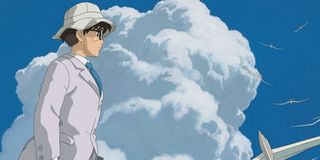NYFF Review: Hayao Miyazaki's The Wind Rises

For what may well be Hayao Miyazaki's final film, the world renowned animator turned his attentions away from fantastical tales that have made him a living legend, and to the life of aeronautics engineer Jiro Horikoshi. He was the man behind Japan's Mitsubishi A6M Zero fighter plane, which was used as a dogfighter and later in kamikaze missions during World War II. Though Miyazaki has left behind his cavalcade of silly spirits and magical beasts, there is no shortage of wonder in The Wind Rises.
The story begins with Jiro as a small boy who dreams of fantastical planes. Miyazaki uses these dreams to bleed reality into fantasy and premonition. In this surreal world of extraordinary flying machines, Jiro meets his idol, Italian plane designer Gianni Caproni. Much like Remy the rat of Ratatouille creates a personal Gusteau to play mentor for him as he pursues his dream of becoming a great chef, Jiro visits this dream space throughout his life to speak with his idol as he seeks inspiration, encouragement, and even absolution. This thread of dreams and inspiration slipping into Jiro’s reality obviously makes this biopic less than accurate, but beautiful in its expression of creative thought. Adding to the film's sense of wonder is a sound design made by human mouths emitting whirs, thuds, and rumbles, in lieu of more traditional foley effects. These human sounds make these wood and metal planes feel organic and alive. Engineers, the film shows, are people who build our futures from wisps of their dreams. Through Miyazaki’s interpretation this is no cold vocation of math and metal, but a fluid expedition for functionality to meet beauty.
Along Jiro's quest to build his ideal plane, he meets a lovely but frail young woman named Nahoko. Their love story drives home one of the film's main themes from French poet Paul Valery, translated as, "When the wind rises, we must try to live!" For the couple this means a rush to marry, and for Jiro it means turning the beautiful flying machines of his dreams into fully operational planes for the Japanese military as talk of war brews. This is the cruel contradiction of his craft. Jiro designs gorgeous planes for flight, but is aware that these creations become weapons, and tools of war. He and Caproni revisit this thread throughout the film, admitting the dream of beautiful planes is a "cursed" one. However, this theme is only lightly touched on in visuals. Jiro has visions of burning planes, and laments that not one of his Zero fighters returned from their mission, which were arguably suicide missions. Yet it makes no mention of the human causalities of his creation. To me, this was a strange omission. While its not Jiro's motivation to create weapons of war, it is his reality. It is all a part of the man's legacy for better or worse, but one Miyazaki seems eager to brush over.
Still, The Wind Rises is awe-inspiring. Without the mystical creatures about, Miyazaki finds heart stopping beauty and grace in everyday moments, and captures them in glorious hand-dawn animation. The way a headlight's beam plays across a cobblestone street, or how fabric and hair flutters in a rippling wind, or the shimmer of water rambling down a stream are made new and remarkable through Miyazaki's delicate drawings. Couple this with the tenderness he has for his characters—making even their clumsiness into a lovely motion and giving them privacy in their most intimate moments—and it gives the film a thudding heart thumping at its core.
While I wished this modern master had dug a little deeper into the dark terrain of Jiro’s life, I was ultimately in awe of The Wind Rises. The animation is as glorious as we’ve all come to expect from Miyazaki, and really is reason enough to see this film. But what makes this venture standout from the rest of his great works is how it makes lovely little moments that might have gone unnoticed if this story were life-action. It’s impossible to shake the thought that someone had to sketch and color every moment, from Jiro tossing a paper airplane, to the terrible lurching ground of the 1923 Great Kanto Earthquake, and the every jostle of crowds of people streaming in city streets. The workmanship evident underlies the story of Jiro, the story of arduous creation. It’s a great deal of work, but in the end it can result in something unique and glorious.
The Wind Rises will make its US premiere at the New York Film Festival on September 28th. A second screening will follow on October 4th, and a brief theatrical run will begin in New York and Los Angeles on November 8th. A wider Disney-backed release will come in 2014.
CINEMABLEND NEWSLETTER
Your Daily Blend of Entertainment News
Staff writer at CinemaBlend.
Most Popular






